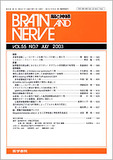Japanese
English
- 有料閲覧
- Abstract 文献概要
- 1ページ目 Look Inside
要旨 患者は46歳男性。39歳時に左上肢巧緻運動障害で発症し,無動および固縮が認められたため若年性パーキンソニズムと診断された。L-dopa製剤が著効したが,服薬開始後約4年でwearing-off現象とoff時に体幹を左に傾ける体幹ジストニアが出現した。神経学的には,左側優位の歯車様固縮・無動が認められたが小脳徴候や自律神経徴候は明らかではなかった。頭部MRIでオリーブ橋小脳萎縮を示唆する病変が認められ,多系統萎縮症(MSA)が疑われた。画像上基底核に異常信号・萎縮を認めなかった。多系統萎縮症に伴うパーキンソニズムでも,L-dopaの効果が長期に保たれる場合があり,パーキンソン病との鑑別が困難となる。このような症例では黒質病変が主体で,線条体病変が軽度であった可能性がある。またMSAにおけるジストニアは,L-dopa治療前に認められるdisproportionate antecollisが主なものであり,本症例で認められたような,L-dopa誘発性の体幹のoff-dystoniaは極めて稀であると考えられた。
A 46-year-old man had a 7-year history of dopa-responsive parkinsonism. Four years after starting levodopa, he had typical motor complications such as wearing-off and peak dose as well as off-period dystonia of his trunk. Brain MRI showed marked atrophy of the brainstem and cerebellum, and the cross sign was present in the pontine base. There was neither abnormal signal intensity nor atrophy in the basal ganglia. Then, he was suspected as having multiple system atrophy (MSA). It is not easy to differentiate MSA from Parkinson disases, particularly when the patient shows good response to levodopa and motor complications like those seen in Parkinson's disease. If the striatal pathology was not severe and nigral degeneration was prominent, presynaptic parkinsonism might occur in MSA, and putaminal preservation might account for good response to levodopa therapy. In patients with MSA, disproportionate antecollis is common before levodopa treatment, and levodopa induced off-dystonia of his trunk is very rare.

Copyright © 2003, Igaku-Shoin Ltd. All rights reserved.


